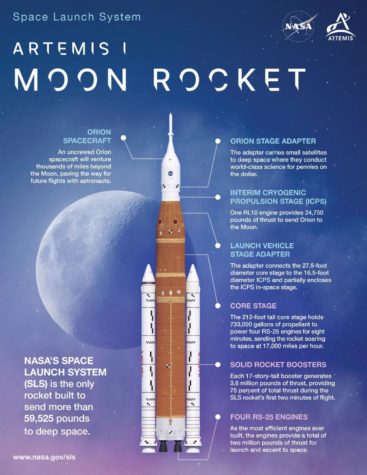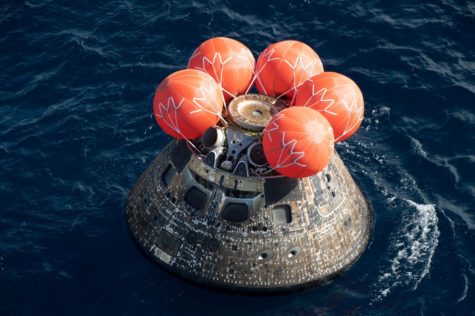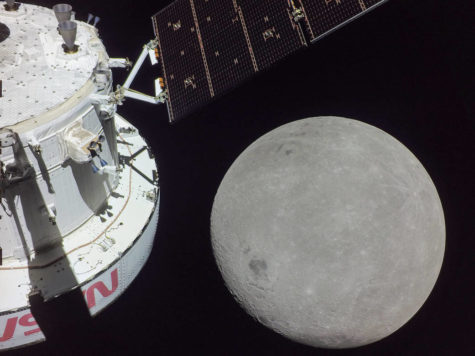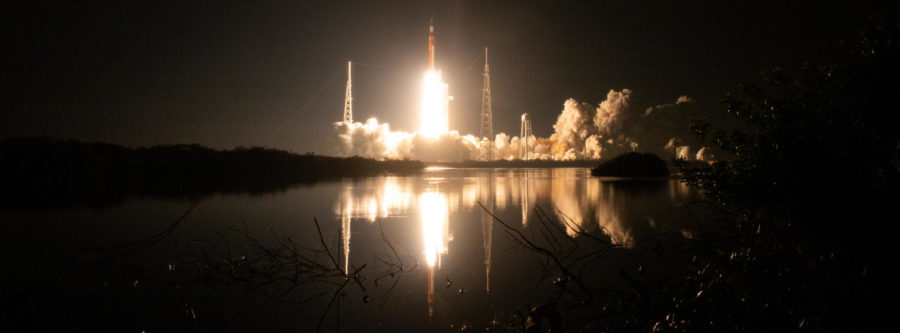Artemis 1: The Beginning of a Revolutionary Space Program
NASA launched its first Artemis rocket, part of the Artemis mission to get humans back on the moon, on November 16th 2022.
The Artemis 1 rocket lights up the night sky onNovember 16th, 2022.
Artemis is the Greek Goddess of the Moon, daughter of the King of the Gods and twin sister of the God of the Sun. She is, then, the fitting representative of NASA’s new space program The Artemis program is building on the goals of its predecessor, the Apollo program, in order to establish the first long-term human presence on the Moon and inspire a new generation of American explorers. In collaboration with international and commercial partners, NASA plans to propel American leadership in space exploration and build a global network of discovery through Artemis.
As of right now, four Artemis launch missions are proposed and the program will continue far into the coming decade. Near the end of 2022, Spectators across the world watched as the Artemis I rocket blazed into the sky, symbolizing a new era of space exploration. Aboard Artemis I was a set of mannequins, but NASA’s future missions will include living humans, with the hope of incorporating a diverse set of astronauts. The official Artemis website claims the mission will send the first woman and first person of color to the Moon.

At the heart of Artemis’ proposed missions is the Orion Spacecraft, built to serve as the manning and equipment vessel. The Lockheed Martin Corporation, a prominent U.S. weapons contractor, was responsible for the design and build. Pictures taken aboard Orion on Artemis 1 have already mesmerized space enthusiasts and NASA promises that Orion will be outfitted with even more sophisticated technologies on future missions. It plans to outfit future missions with scientific observational equipment, some of which may be used to sample water-ice for the first time.
The Space Launch System (SLS) also deserves praise. Developed collaboratively by Aerojet Rocketdyne, Boeing, Northrop Grumman, and Teledyne Brown in 2016, it is the first SLS to ever be used in space flight. Artemis I’s successful launch has certainly sparked great interest in this system and is a key example of corporate collaboration on this program. Although first developed for the previously canceled program Constellation, SLS now serves as a great addition to the Artemis arsenal.
The importance of these two systems is magnified in Artemis I’s official name, “The First Uncrewed Integrated Launch Flight Test of NASA’s Orion Spacecraft and Space Launch System Rocket.”
Launch Day
Currently, the Artemis team is far away its chartered goal. Artemis I consisted of a round trip to the Moon and back to Earth. It lasted a mere 25 days, launching on November 16th, 2022, and splashing back down on December 11th, 2022.
Artemis I wasn’t without delays, being scheduled to launch three times before its actual launch in November. The first launch was set for August 29th at Kennedy Space Center, but engine issues kept Artemis grounded. Launch was then rescheduled for September 3rd, but fuel leaks derailed plans. Tropical Storm Ian would delay Artemis for a final time until September 24th.

(NASA / James M. Blair)
It is important to note that NASA delays are not out of the ordinary due to the many factors that can delay or cancel the launch. Unexpected weather conditions or sudden issues with the launching equipment happen often and contribute to the bulk of launch delays. Many chalk this up to NASA’s extreme caution and concern for safety. When it did launch, hundreds of thousands watched in person at Cape Canaveral, and millions more tuned into NASA’s youtube live stream. Weather conditions were set and the window to reach the Moon was soon to close.
As Launch Director Charlie Blackwell Thompson completed the final survey of the launch room, the SLS kicked into gear. T-10 seconds and the hydrogen burn-off igniters were initiated. T-5 seconds and the 4-stage engines flared to life. T-0 seconds and Artemis I blasted off, lighting up the night at 1:47 A.M EST. NASA Launch reporter Brett Tingley said, “we rise together back to the Moon and beyond.”
As NASA administrators celebrated, Artemis’ job was just beginning. At that point, the Orion Spacecraft would be well on its way to the moon. Flight operators would be crossing their fingers the whole way there; it would be a fight against time to guide Orion to its proper course. Like any other spacecraft, it needed to get out of Earth’s gravitational pull and once it did, no more correctional adjustments could be made to its course.
After liftoff, Orion entered outbound transit, exiting the Earth’s atmosphere and escaping its gravity. From here on out, it was one groundbreaking event after another.
On November 20th, 2022, the 5th flight day, the Moon became the primary gravitational force acting on Artemis. The day after that, Orion began to transit into Distant Retrograde Orbit (DRO), an orbit that is the opposite of the Moon’s. Orion is the first spacecraft to be observed entering this specific type of orbit.

(NASA)
November 26th represented another special day at NASA, as Orion traveled a record breaking 248,654 miles from Earth, surpassing the Apollo 13 mission’s distance.
Orion splashed down in the Pacific Ocean exactly 25 days and 10 hours after launch, on schedule. The mission brought nothing back from the Moon for scientists to pore over, but it was a resounding success, bringing excitement and renewed interest in the United States Space Program.
Global Takeaways
NASA has already developed complex plans for future Artemis missions. They plan to launch Artemis 2 no later than 2024. The selection process for the crew is scheduled to complete early in 2023. As of publication, no official announcements have been made.
Interestingly enough, Artemis was designed as a global collaboration project and was meant to diffuse tensions with major U.S. adversaries. The Artemis Accords, signed in 2020, are a clear sign of this initiative. As NASA states, “The Artemis Accords will describe a shared vision for principles, grounded in the Outer Space Treaty of 1967, to create a safe and transparent environment which facilitates exploration, science, and commercial activities for all of humanity to enjoy.” So far, 23 countries and one territory have signed on, and NASA anticipates that many more will join after seeing the success of Artemis I.
Just 2 days after the splashdown, NASA welcomed Nigeria and Rwanda as new Artemis Accord signatories. NASA administrator Bill Nelson said, “I’m thrilled Nigeria and Rwanda are committing to the safe, sustainable use of outer space. In an era where more nations than ever have space programs, today’s signings highlight a growing commitment to ensuring space exploration is conducted responsibly.”
But, Artemis is still the culmination of a tumultuous few decades of space initiatives by NASA and U.S. legislators. The previous Constellation Program was proposed under the Bush Administration as a complement to the Vision for Space Exploration policy that was introduced by George W. Bush in 2004. It was later scrapped by the Obama Administration over budgetary concerns.
As discussed before, a great deal of the equipment used by Artemis was contracted much earlier, since many of them were originally designed to serve Constellation. Orion and SLS were both conceived in the early 2000s and remained under contract with NASA until they could be used in a new mission.
In 2017, former President Trump signed SpacePolicy Directive 1, advising NASA to “lead an innovative and sustainable program of exploration with commercial and international partners to enable human expansion across the Solar System and to bring back to Earth new knowledge and opportunities.” These efforts culminated in the development of Artemis, a specialized space program designed to combine NASA’s expertise with corporate space technologies.
Considering the current successes, it is unlikely that the Artemis Program will be scraped, or “shelved” as NASA puts it. The moon isn’t the end goal. Numerous NASA officials have stated the Artemis missions are designed to propel us onto Mars.
They say that the moon is a launching ground, both figuratively and literally, that gives us the capacity to explore further in our solar system. The ambition of NASA within the Artemis program creates promise for the expansion of space initiatives. If what they claim is true, future generations of Americans will look back and see Artemis as a beacon of hope for space exploration beyond our planetary reaches.
The ambition of NASA within the Artemis program creates promise for the expansion of space initiatives. If what they claim is true, future generations of Americans will look back and see Artemis as a beacon of hope for space exploration beyond our planetary reaches.
Evan Li is a Features Editor for ‘The Science Survey.' He enjoys writing articles about political news and the sciences, areas that reflect current events...

